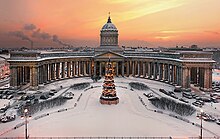Kazan Cathedral, St. Petersburg
| Kazan Cathedral | |
|---|---|

Kazan Cathedral in winter
|
|
| Basic information | |
| Location | Nevsky Prospect, 25 Saint Petersburg, Russia |
| Affiliation | Russian Orthodox |
| Ecclesiastical or organizational status | cathedral |
| Status | Active |
| Website | kazansky-spb |
| Architectural description | |
| Architect(s) | Andrey Voronikhin |
| Architectural style | Empire |
| Groundbreaking | 1801 |
| Completed | 1811 |
| Specifications | |
| Width | 56.7 m |
| Height (max) | 69 m |
Kazan Cathedral or Kazanskiy Kafedralniy Sobor (Russian: Каза́нский кафедра́льный собо́р), also known as the Cathedral of Our Lady of Kazan, is a cathedral of the Russian Orthodox Church on the Nevsky Prospekt in Saint Petersburg. It is dedicated to Our Lady of Kazan, probably the most venerated icon in Russia.
Construction of the cathedral started in 1801 and continued for ten years under the supervision of Alexander Sergeyevich Stroganov. Upon its completion in 1811, the new temple replaced the Church of Nativity of the Theotokos, which was disassembled when the Kazan Cathedral was consecrated.
The architect Andrey Voronikhin modelled the building on St. Peter's Basilica in Rome. Some art historians assert that Emperor Paul (reigned 1796-1801) intended to build a similar church on the other side of Nevsky Prospect that would mirror the Kazan Cathedral, but such plans failed to materialize. Although the Russian Orthodox Church strongly disapproved of the plans to create a replica of a Catholic basilica in Russia's then capital, several courtiers supported Voronikhin's Empire Style design.
After Napoleon invaded Russia (1812) and the commander-in-chief General Mikhail Kutuzov asked Our Lady of Kazan for help, the church's purpose altered. The Patriotic War over, Russians saw the cathedral primarily as a memorial to their victory over Napoleon. Kutuzov himself was interred in the cathedral in 1813; and Alexander Pushkin wrote celebrated lines meditating over his sepulchre. In 1815 keys to seventeen cities and eight fortresses were brought by the victorious Russian army from Europe and placed in the cathedral's sacristy. In 1837, Boris Orlovsky designed two bronze statues of Kutuzov and of Barclay de Tolly which stand in front of the cathedral.
...
Wikipedia
